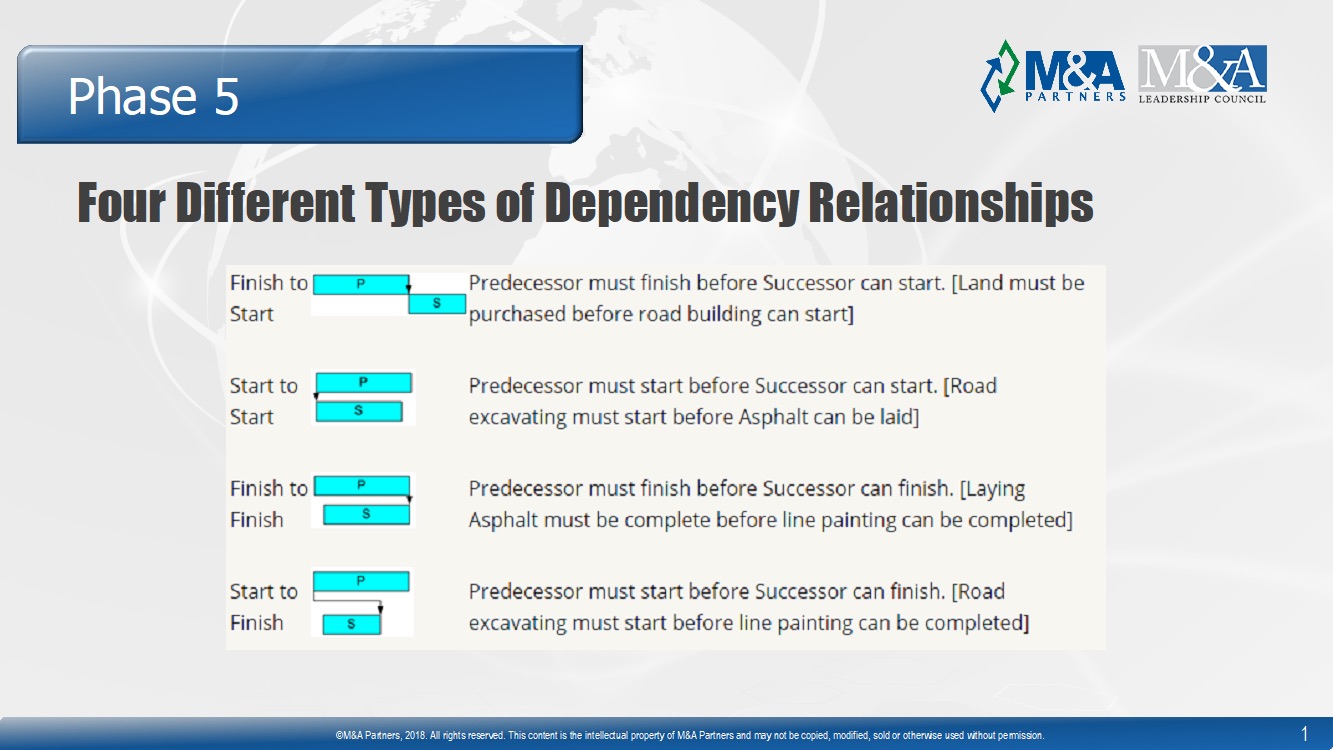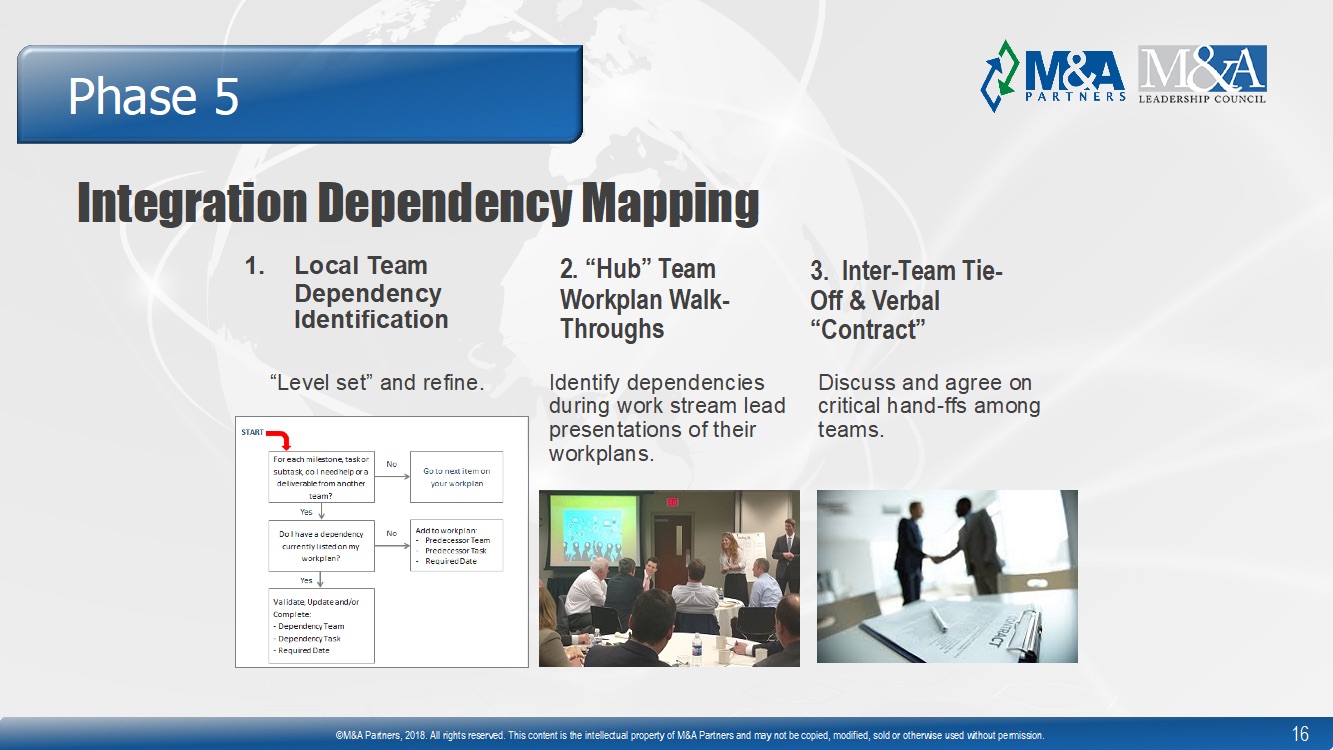By Darren McKnight, Senior Partner, and
Mark Herndon, President
M&A Partners
Post-merger integration is complex business, with multiple and parallel overlapping requirements for success.
While the ultimate goal of any acquisition integration is to capture the full deal value as described on Announcement Day, that challenge often pales in comparison to the herculean task of translating the strategic reason for doing the deal into the operational tactics of actually making the deal work! Frankly, it’s hard enough just gaining solid alignment of all functional teams, processes, systems, applications and operating models. For most companies, however, the difficulty factor and risks are often greatest when trying to identify and effectively manage myriad cross-functional dependencies – those critical, core integration milestones, tasks, decisions and requirements that require multiple teams, leaders and disciplines to understand, execute and enable actions reaching far beyond their own functional domains.
The enormous importance of getting cross-functional dependencies right was confirmed recently in a study conducted by the M&A Leadership Council and M&A Partners, called The State of M&A Integration Effectiveness. When analyzing which specific integration best practices most strongly correlated with specific business result outcomes, the effective management of cross-functional dependencies proved to be the fifth-most highly correlated integration best practice driving successful cost synergy capture goals. Compared to the acquirers who were least effective at managing cross-functional dependencies, those who got it right were 67% more likely than the control group to achieve their targeted cost synergies.
In our experience over the last 20 years leading companies through integration, we’ve found 7 essential keys for managing and executing cross-functional dependencies. Build these practices and skill sets in your organization, and you, too, will be far more likely to get the business results and integration KPIs your leadership team is counting on.
1. Create a Common Understanding of Cross-Functional Dependencies. Whatever you do, don’t skip this all-important first step. Make sure your teams understand what dependencies are, the different kind of dependencies they may encounter, the overall process your organization has defined to identify and manage dependencies and what you expect of each functional leader in order to succeed. For example, we often find that most function team leaders have never realized that there are multiple types of dependencies and that each type may substantially impact the timing and workflow of multiple tasks or sub-milestones. The illustration (below) points out four common types of dependencies. Make sure you identify specific, concrete examples of each relevant type for your industry, integration and the functions at hand.

2. Implement a Robust Discovery Process Between Workstream Leaders from both Buyer and Target. While the degree of pre-close access and information sharing will be determined by legal counsel and the deal team, we strongly encourage organizations to launch Discovery pre-close if at all possible. Other organizations may prefer to make Discovery the first substantive step in launching post-close integration planning. If pre-close, be sure to emphasize that this is not due diligence, although there are many strong parallels. In our view, Discovery is a highly collaborative process intended to build a solid understanding of each organization’s functional operating model at a level of detail that is typically not possible during due diligence. Instead, Discovery is intended to provide a structured, robust and accelerated process to ensure that each workstream team has sufficient functional and operational context, insight, relationships and nuanced understanding of BOTH companies’ functional operating models to begin making essential integration recommendations and decisions. Feel free to adjust the number, type and level of Discovery categories to your specific purposes, but be sure to require enough that each workstream produces a meaningful summary of each counterpart’s organization, key processes, systems, culture and resources. It is especially important to understand the unique functional capabilities and attributes that drive business performance – what we call “secret sauce.” Understanding key similarities and differences, unique capabilities and high-priority integration requirements for each workstream become an essential foundation for identifying the early cross-functional dependencies and developing a comprehensive functional integration workplan.
3. Capture Dependencies in the Initial Draft Functional Integration Milestone Plan. For each functional area, an agreement among the workstream leads (or workstream pair) should be reached on the high priority integration items at the key milestones level required to move from the current or as-is state to the future, to-be state for all of the workstream processes and systems. For each key milestone, determine the “what” (process or system) to be integrated, the timing in which the integration will occur and the owner for each portion of the integration. Then for each milestone, identify if there are any cross-functional dependencies – in essence, a deliverable or set of deliverables from one or multiple functional areas in order to complete the milestone. Aggregate all of the milestones and cross-functional dependencies identified, as applicable, for each milestone into a single functional integration plan.
4. Conduct a Joint Integration Planning Workshop. Once each functional area has completed their respective functional integration plan with a set of key milestones and cross-functional dependencies, and once you as the Integration Leader have reviewed, vetted and approved each function’s milestone plans, the overall integration team is ready for a joint integration planning workshop. In the Joint Integration Planning Workshop, each workstream pair presents their functional integration plan to all of the other workstream pairs. They describe the key milestones for their respective functional area and the timing for each milestone to complete, highlighting cross-functional dependencies for each milestone in order to complete the milestone as per the prescribed timing. This will enable other workstream pairs to understand the key milestones and the deliverables expected to achieve the presenting team’s functional plan. Be sure to leave time for confirming or negotiating the timing of deliverables and aligning on the plan between the functional teams. Document all the agreements made between functional areas, including the owner and due date for each dependency deliverable. We routinely do a substantial portion of our clients’ integration planning workshops via remote meeting, but we have learned over the years that there is a distinct and vital quality improvement when workstream leaders from both organizations have met in person, worked in the trenches directly together and share a mutual conviction for doing what it takes to get the job done. Thus our strong preference for conducting these sessions in person, whenever possible, with key workstream leaders from both Buyer and Target.
5. Complete the Detailed Integration Plans. The workstream pairs then work to complete the development of their respective functional integration plan. This will include updating their functional plans with key milestones, considering the timing negotiated for each cross-functional dependency and working with their sub-workstream leads to develop the task level of detail in their functional plans for all processes and systems. Specific dates, accountabilities, roles/responsibilities and “cost-to-capture” data are added at this level.
6. Conduct a Formal Dependency Mapping Workshop. For the vast majority or organizations – even those highly experienced with integration – the Dependency Mapping Workshop is an essential success requirement. This is the principal event where cross-functional dependencies are discussed, agreed upon and fully documented. This enables the development of the final enterprise-level integration workplan, including all functional and cross-functional requirements. We often refer to this as the Integrated Plan of Record and, in all cases, is everything needed to effectively execute the entire integration plan across the entire enterprise, including milestones and tasks for each workstream; identified dependencies; assigned owners; budgets; resources; and negotiated (or mapped) timing. Keep in mind that once an Integration Plan of Record is developed for a deal, it must be locked and remain unchanged unless approved by change order. It takes a great amount of time, work, structure, discipline and skill to create an effective Integrated Plan of Record, but once completed, you can make it into a template to use with similar deals in the future. This will help accelerate the integration planning process and enable faster value capture for each future deal.

One final insight on this step: getting dependencies right is not just about robust planning and fully detailed analysis. We learned long ago that true success with cross-functional dependencies has as much, if not more, to do with the interpersonal commitments made between the workstream leaders themselves. At the conclusion of our workshops, we strongly recommend a personal commitment step between those most responsible for effectively executing their respective dependencies. Unless you get this level of personal commitment, it’s just a static plan that could get derailed by a hundred factors. But once you lock in the personal commitment leader to leader, it becomes far more than a plan – it’s a personal contract.
7. Executive Review, Approval and Launch of Execution. Surprisingly, this is a frequently overlooked step. But skip it at your peril. Without adequate executive-level review, involvement, budgeting, resourcing and formal commissioning, many integration efforts are little more than wishful thinking. When the Integrated Plan of Record is approved by the Leadership team, the management and execution of the plan finally commences. It is essential that meetings between the Integration Management Office and the workstream pairs are conducted at a regular cadence to managing the completion of the dependency deliverables and progress of the overall plan. Document weekly progress against the Integrated Plan of Record and ensure dependencies are being delivered in the time promised. Missing delivery of dependencies can have a domino effect on the overall Integrated Plan of Record. If any deliverables are not completed on time, bring it to the attention of the functional leadership. As risks and issues arise, or decisions are needed, address them quickly, even if prompt escalation is required. Slow reaction time and decision-making erode value capture.
One final lesson learned of the execution phase: we strongly recommend using a relevant third-party software solution to help you track and manage cross-functional dependencies. Without that essential capability, your teams will often lose sight of essential dependencies, dates, commitments and statusing that just doesn’t show up at the level needed in routine functional milestone reporting. This can help track the overall integration and ensure all dependencies and milestones are being completed according to the Integrated Plan of Record. For more information on which M&A purpose-built software solution may be the best fit for your organization, download this free resource linked here: “How Will You Determine the Best M&A Software Solution for Your Company?”)
There’s little wonder why identifying and executing the cross-functional dependencies are typically one of the most difficult parts of integration! The good news is that once you define this type of robust process, your team’s skills at dependencies will definitely improve along with improved business results and integration KPIs. When that skillset is combined with support from effective business sponsor and integration leadership, driven by highly experienced and competent integration program managers and expert-level functional SMEs, you will place your organization firmly in the “best practice” category.
About Darren:
Darren McKnight ([email protected]) is a Senior Partner at M&A Partners and has over 20-years’ experience serving in many M&A capacities including Integration Management Office (IMO) lead, coach and advisor to global clients in various industries, including IT services, cyber security, wireless communications, electrical parts distribution, healthcare and oil & gas.
As the exclusive Integration sponsor of the M&A Leadership Council, M&A Partners leads The Art of M&A Integration training events to prepare your team to maximize deal value through successful integration.
